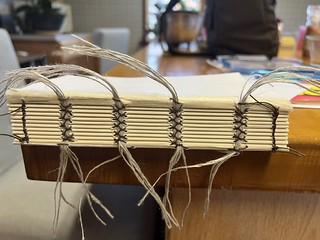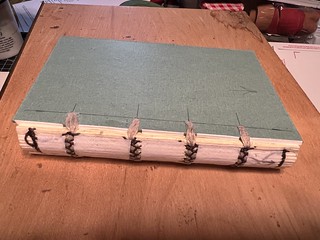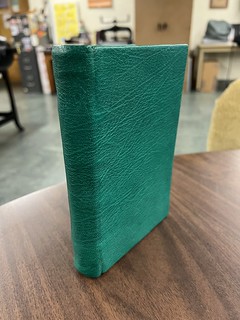I attended back-to-back workshops on leather bookbinding from March until June of this year. These workshops were taught remotely by Karen Hanmer, a gifted binder from Chicago.
The first sessions in March were set aside for learning to use the tools to thin leather. The sessions in April, May and June were devoted to making a binding with a leather cover. My supplies were sent to me and I had a lovely piece of deep turquoise leather to work with, along with thread, endsheet paper and the paper for the text. The text was a public domain version of The Compleat Angler by Isaak Walton (1653).

The text block was sewn up and over three pieces of linen cord, which were laced onto the boards and glued down.
The cords are threaded through the board, which forms a strong attachment. Once the boards were attached to the text block, there was lots of sanding and trimming to smooth everything out.
I trimmed the leather to fit the text pages and boards. The tools used were a spokeshave, a leather paring knife and a Scharf-Fix paring machine. Each of these tools has a specific use in paring leather. As you can imagine, the hinge areas along the spine need to be thinned because they are always being opened and closed and this gives the hinges flexibility. The areas at the head and tail of the spine also need to be very thin, as well as the area along the spine. The paring knife is used to thin leather on the head and tail, and the spokeshave along the spine area. The Scharf-Fix is used on the ‘turn-ins’ which are folded and glued down along the edges of the book boards. Thinning leather is an art, it is finicky, and has a distinct learning curve.
These workshops, although held remotely, are very effective. Each session is recorded and each individual can go back and view the recordings for 90 days after the workshop.



4 Comments on ‘Leather Bookbinding Workshops’
Thanks Craig, it is amazing this was all done remotely, what an experience!
I appreciate your post, Craig! Your craftsmanship truly stands out in the photos, and reflects your exceptional skill.
This is cool! It was all 100% new to me and I appreciated the photos and useful links in particular. Thanks for sharing, Craig.
Beautiful work, Craig, and very useful in keeping our collections happy and healthy!